
Table of Contents for Near Eastern Archaeology 80.4 (December 2017)
Subscription Options
You can receive NEA (and other ASOR publications) through an ASOR Membership or through an Individual Subscription. Single issues (subject to availability) are available for purchase, with ASOR members receiving a discount. Please email us if you have any questions.
Pp. 212-231: “The Tell eṣ-Ṣâfi/Gath Archaeological Project: Overview,” by Aren M. Maeir
The Tell eṣ-Ṣâfi/Gath Archaeological Project commenced in 1996 and is one of the largest and longest continuously running archaeological projects in Israel. As the year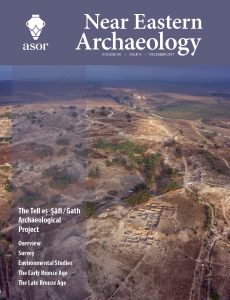
Click here to access the above article on JSTOR (ASOR membership with online access and/or subscription to JSTOR Current Content required).
Pp. 232-240: “Gath of the Philistines in the Bible and on the Ground: The Historical Geography of Tell eṣ-Ṣâfi/Gath,” by Yigal Levin
Archaeology is, for the most part, the study of material remains of the past. Archaeologists survey, excavate, analyze and construct a 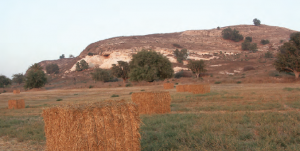
Click here to access the above article on JSTOR (ASOR membership with online access and/or subscription to JSTOR Current Content required).
Pp. 241-243: “New Insights into Bliss and Macalister’s Excavations at Tell eṣ-Ṣâfi/Gath,” by Rona S. Avissar Lewis and Aren M. Maeir
By 1899, Frederick J. Bliss was already a well-known archaeologist when he was asked by the Palestine Exploration Fund (PEF) to excavate the Shephelah mounds. 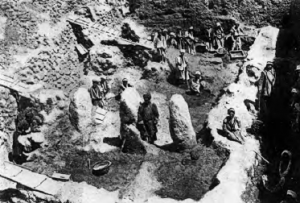
Click here to access the above article on JSTOR (ASOR membership with online access and/or subscription to JSTOR Current Content required).
Pp. 244-246: “Ancient Environment and Human Interaction at Tell eṣ-Ṣâfi/Gath,” by Oren Ackermann, Noam Greenbaum, Hendrik Bruins, Avner Ayalon, Miryam Bar-Matthews, Dan Cabanes, Liora Kolska Horwitz, Frank H. Neumann, Mechael Osband, Naomi Porat, Ehud Weiss and Aren M. Maeir
An archaeological site is an integral part of its surrounding landscape. This is one of the main novel approaches in the long-term archaeological project of Tell eṣ-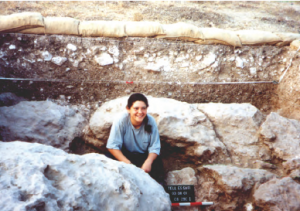
Click here to access the above article on JSTOR (ASOR membership with online access and/or subscription to JSTOR Current Content required).
Pp. 247-254: “The Early Bronze Age at Tell eṣ-Ṣâfi/Gath,” by Haskel J. Greenfield, Itzhaq Shai and Aren M. Maeir
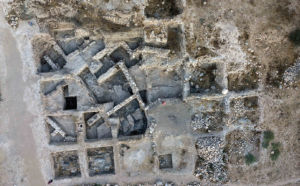
Click here to access the above article on JSTOR (ASOR membership with online access and/or subscription to JSTOR Current Content required).
Pp. 255-258: “Animal Food Production and Consumption in Stratum E5 at Early Bronze Age Tell eṣ-Ṣâfi/Gath,” by Haskel J. Greenfield, Tina L. Greenfield and Annie Brown
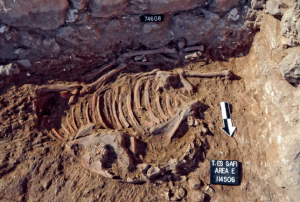
Pp. 259-260: “Microdebris Analysis from the Early Bronze Age Levels at Tell eṣ-Ṣâfi/Gath,” by Annie Brown and Haskel J. Greenfield
Microdebris are the tiny remnants of activities that are not cleaned up after an activity is completed (fig. 1). Such activities are often archaeologically invisible with standard macrolevel artifact collection and analysis techniques. If microdebris are systematically and spatially collected across surfaces and different depositional contexts, their analysis can help guide excavation strategies (identification where such debris is located, which deposits are worth floating), identify activity areas, pest distributions, when, and which, rooms were used or abandoned, missing food sources that cannot be recovered through hand collections (plants, fish, and smaller remains), and so on (Rainville 2012; Steadman 1996; Rosen 1989; Weiner 2010). The utility of this approach is demonstrated with data from the Early Bronze Age excavations in Area E at Tell eṣ-Ṣâfi/Gath.
Click here to access the above article on JSTOR (ASOR membership with online access and/or subscription to JSTOR Current Content required).
Pp. 261-263: “Isotope Analyses of Early Bronze Age Fauna at Tell eṣ-Ṣâfi/Gath,” by Elizabeth R. Arnold and Haskel J. Greenfield
Click here to access the above article on JSTOR (ASOR membership with online access and/or subscription to JSTOR Current Content required).
Pp. 264-267: “Interregional Trade and Exchange at Early Bronze Age Tell eṣ-Ṣâfi/Gath,” by Elizabeth Arnold, Jeremy Beller, Adi Behar, David Ben-Shlomo, Tina L. Greenfield and Haskel J. Greenfield
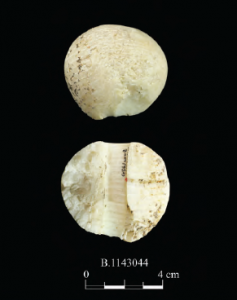
Pp. 268-269: “Spatial Reconstruction of Selected Finds from the Early Bronze Age Neighborhood at Tell eṣ-Ṣâfi/Gath, Area E,” by Tina L. Greenfield and Andrea Squitieri
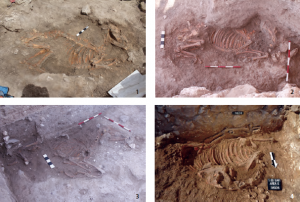
Pp. 270-272: “Evidence for Administration and Leisure/Recreation at Early Bronze Age Tell eṣ-Ṣâfi/Gath,” by Shira Albaz, Haskel J. Greenfield, Tina L. Greenfield and Aren M. Maeir
Click here to access the above article on JSTOR (ASOR membership with online access and/or subscription to JSTOR Current Content required).
Pp. 273-275: “Ceramic Vessel Production and Use at Early Bronze Age Tell eṣ-Ṣâfi/Gath,” by Jon Ross and David Ben-Shlomo
Click here to access the above article on JSTOR (ASOR membership with online access and/or subscription to JSTOR Current Content required).
Pp. 276-278: “Archaeological Science in the Early Bronze Age Levels,” by Adi Eliyahu-Behar
Click here to access the above article on JSTOR (ASOR membership with online access and/or subscription to JSTOR Current Content required).
Pp. 279-281: “Early Bronze Age Basalt Vessel Remains from Tell eṣ-Ṣâfi/Gath,” by Jeremy A. Beller
Basalt is long thought to have been one of the more valued geological materials from which ground stone objects were manufactured (Ebeling and Rowan 2004: 108; Milevski 2008). Although it was readily available in some regions of the southern Levant, the widespread utilization of basaltic material was likely due to its physical and aesthetic properties. As a quick-cooling, extrusive igneous rock, basalt is dominated by mafic minerals and characterized by a high durability and hardness (Mohs’ scale 7), a fine-grained texture, and a green-black colored appearance (Le Maitre 2002). Furthermore, basalt sheens well and leaves less grit in processed food than other materials (Ebeling and Rowan 2004: 108).
Click here to access the above article on JSTOR (ASOR membership with online access and/or subscription to JSTOR Current Content required).
Pp. 282-284: “Building a City Wall: An Administrative Perspective,” by Jill C. Katz
During the Early Bronze Age II/III, Tell eṣ-Ṣâfi/Gath was fortified by a city wall. This wall has been exposed now in several areas, stretching from the acropolis in the west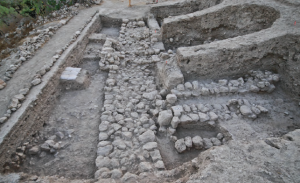
Click here to access the above article on JSTOR (ASOR membership with online access and/or subscription to JSTOR Current Content required).
Pp. 285-291: “Walled Up To Heaven! Early and Middle Bronze Age Fortifications at Tell eṣ-Ṣâfi/Gath,” by Jeffrey R. Chadwick, Joe Uziel, Eric L. Welch and Aren M. Maeir
The Early Bronze Age city at Tell eṣ-Ṣâfi/Gath was among the largest urban centers in Canaan, or whatever they called their land at that time (Maeir 2012b: 13; Shai et al. 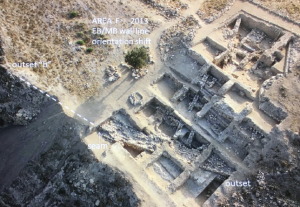
Click here to access the above article on JSTOR (ASOR membership with online access and/or subscription to JSTOR Current Content required).
Pp. 292-295: “The Late Bronze Age at Tell eṣ-Ṣâfi/Gath,” by Itzhaq Shai, Joe Uziel, Jeffrey R. Chadwick and Aren M. Maeir
The story of Canaanite Gath begins with the el-Amarna texts (Na’aman 1979; Rainey 2012; Levin, this issue), where it appears that the city was a major contender in the Shephelah power plays of the fourteenth century B.C.E. While some have contended the connection between Gath, Tell eṣ-Ṣâfi and the Amarna period ruler Šuwardatu (Moran 1992: 384), the petrographic examination conducted on the tablets create a strong link between them (Goren, Finkelstein, and Na’aman 2004: 280–86). In this light, the results of the surface survey prior to the onset of the excavations noted the existence of a large settlement at Tell eṣ-Ṣâfi/Gath (ca. 27 ha; see:Uziel and Maeir 2005: 56). Yet, the survey results did not allow identification of differences within the Late Bronze Age (LB) between the subphases of the period.
Click here to access the above article on JSTOR (ASOR membership with online access and/or subscription to JSTOR Current Content required).
Pp. 296-297: “Late Helladic Imported Pottery at Tell eṣ-Ṣâfi/Gath,” by Philipp W. Stockhammer
Fragments of thirty-six Aegean-type vessels were found at Tell eṣ-Ṣâfi/Gath in Areas A, E, F, and P between 1996 and 2014, some of which have already been published (Gadot, Yasur-Landau, and Uziel 2012; Shai et al., this issue) and then subsequently revaluated in a broader context (Stockhammer in press). The earliest import so far can be dated to the Mycenaean pottery phase Late Helladic (LH) IIIA1, which is the late fifteenth and early fourteenth centuries B.C.E. This closed vessel of unclear shape can be considered as one of the early Mycenaean imports to the southern Levant. It reached this region in a time when the spectrum of imports was still dominated by Aegean-type pottery from Crete.
Click here to access the above article on JSTOR (ASOR membership with online access and/or subscription to JSTOR Current Content required).
Pp. 298-299: “Fragments of Egyptian Writing from Tell eṣ-Ṣâfi/Gath,” by Stefan Jakob Wimmer
Some Egyptian inscriptions from Tell eṣ-Ṣâfi/Gath are found on amulets, such as a miniature figurine of the goddess Isis suckling the baby Horus and identified on the back pillar with a few hieroglyphs as 3s.t wr.t nb.t “Isis the Great, the Mistress” (Wimmer and Görg in press), and of course on scarabs (e.g., Münger, NEA forthcoming), such as abound on practically all sites in the Levant. Apart from these, traces of Egyptian writing are sparse at Tell eṣ-Ṣâfi/Gath.
Click here to access the above article on JSTOR (ASOR membership with online access and/or subscription to JSTOR Current Content required).
To view the entire issue on JSTOR, click here.